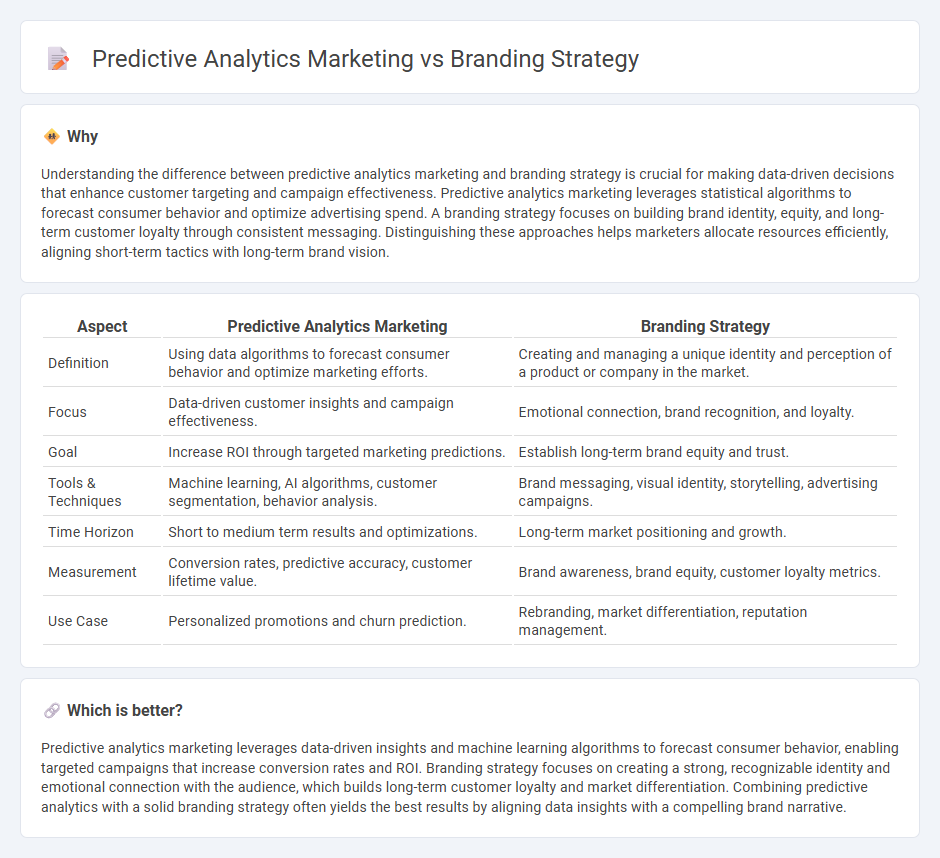
Predictive analytics in marketing leverages data-driven insights to forecast consumer behavior and optimize campaign effectiveness, enhancing targeted outreach and resource allocation. In contrast, branding strategy focuses on creating a consistent and compelling brand identity to build customer loyalty and long-term recognition. Explore how integrating predictive analytics can amplify your branding efforts for measurable growth.
Why it is important
Understanding the difference between predictive analytics marketing and branding strategy is crucial for making data-driven decisions that enhance customer targeting and campaign effectiveness. Predictive analytics marketing leverages statistical algorithms to forecast consumer behavior and optimize advertising spend. A branding strategy focuses on building brand identity, equity, and long-term customer loyalty through consistent messaging. Distinguishing these approaches helps marketers allocate resources efficiently, aligning short-term tactics with long-term brand vision.
Comparison Table
| Aspect | Predictive Analytics Marketing | Branding Strategy |
|---|---|---|
| Definition | Using data algorithms to forecast consumer behavior and optimize marketing efforts. | Creating and managing a unique identity and perception of a product or company in the market. |
| Focus | Data-driven customer insights and campaign effectiveness. | Emotional connection, brand recognition, and loyalty. |
| Goal | Increase ROI through targeted marketing predictions. | Establish long-term brand equity and trust. |
| Tools & Techniques | Machine learning, AI algorithms, customer segmentation, behavior analysis. | Brand messaging, visual identity, storytelling, advertising campaigns. |
| Time Horizon | Short to medium term results and optimizations. | Long-term market positioning and growth. |
| Measurement | Conversion rates, predictive accuracy, customer lifetime value. | Brand awareness, brand equity, customer loyalty metrics. |
| Use Case | Personalized promotions and churn prediction. | Rebranding, market differentiation, reputation management. |
Which is better?
Predictive analytics marketing leverages data-driven insights and machine learning algorithms to forecast consumer behavior, enabling targeted campaigns that increase conversion rates and ROI. Branding strategy focuses on creating a strong, recognizable identity and emotional connection with the audience, which builds long-term customer loyalty and market differentiation. Combining predictive analytics with a solid branding strategy often yields the best results by aligning data insights with a compelling brand narrative.
Connection
Predictive analytics enhances marketing and branding strategies by analyzing consumer data to forecast trends, customer behaviors, and preferences. This enables brands to tailor campaigns, optimize targeting, and allocate resources efficiently for higher ROI. Integrating predictive insights into branding decisions strengthens market positioning and drives customer loyalty through personalized experiences.
Key Terms
Branding Strategy:
Branding strategy centers on creating a strong, consistent brand identity that resonates with target audiences, shaping perceptions and building long-term loyalty through visual elements, messaging, and customer experience. It leverages market research, competitor analysis, and brand positioning to differentiate products and services effectively. Explore more about developing impactful branding strategies to elevate your market presence and customer engagement.
Brand Positioning
Brand positioning emphasizes creating a unique and consistent image in the consumer's mind, leveraging brand identity, values, and emotional connections to differentiate from competitors. Predictive analytics marketing uses data-driven insights, machine learning models, and customer behavior patterns to forecast trends and optimize targeted campaigns. Explore how blending brand positioning with predictive analytics can enhance marketing precision and long-term customer loyalty.
Brand Identity
Brand identity centers on crafting a consistent and recognizable image that resonates with target audiences through logos, messaging, and values, establishing emotional connections. Predictive analytics marketing leverages data-driven insights to anticipate customer behaviors and personalize brand interactions, enhancing relevance and engagement. Explore how integrating these approaches can amplify your brand's impact and customer loyalty.
Source and External Links
What Is Brand Strategy? Definition and Guide (2024) - Shopify - A brand strategy is a holistic approach to building brand identification and favorability with key elements including a compelling brand story, brand voice, brand identity design, brand values, and brand vibe, all designed to deepen customer connection and loyalty.
Brand Strategy: How to Create a Strong, Scalable Brand - Frontify - Key elements of brand strategy include setting clear objectives, articulating mission and vision statements, identifying target audiences through research and personas, developing a messaging framework, and establishing a consistent visual identity.
12 Brand Strategy Examples for Successful Marketing | Indeed.com - Examples of brand strategies include differentiation branding, which makes a company unique and desirable to customers, and product branding, which focuses on making a single product instantly recognizable through symbols and design.
 dowidth.com
dowidth.com